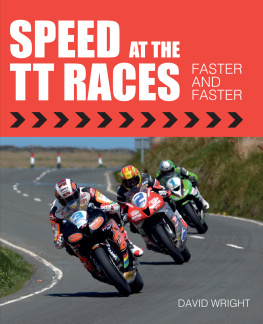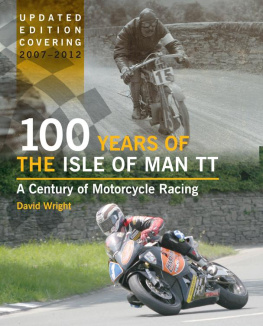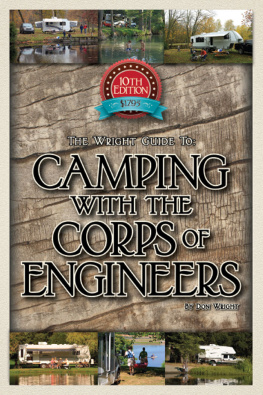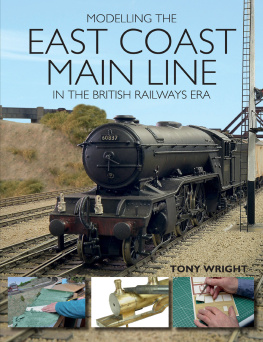
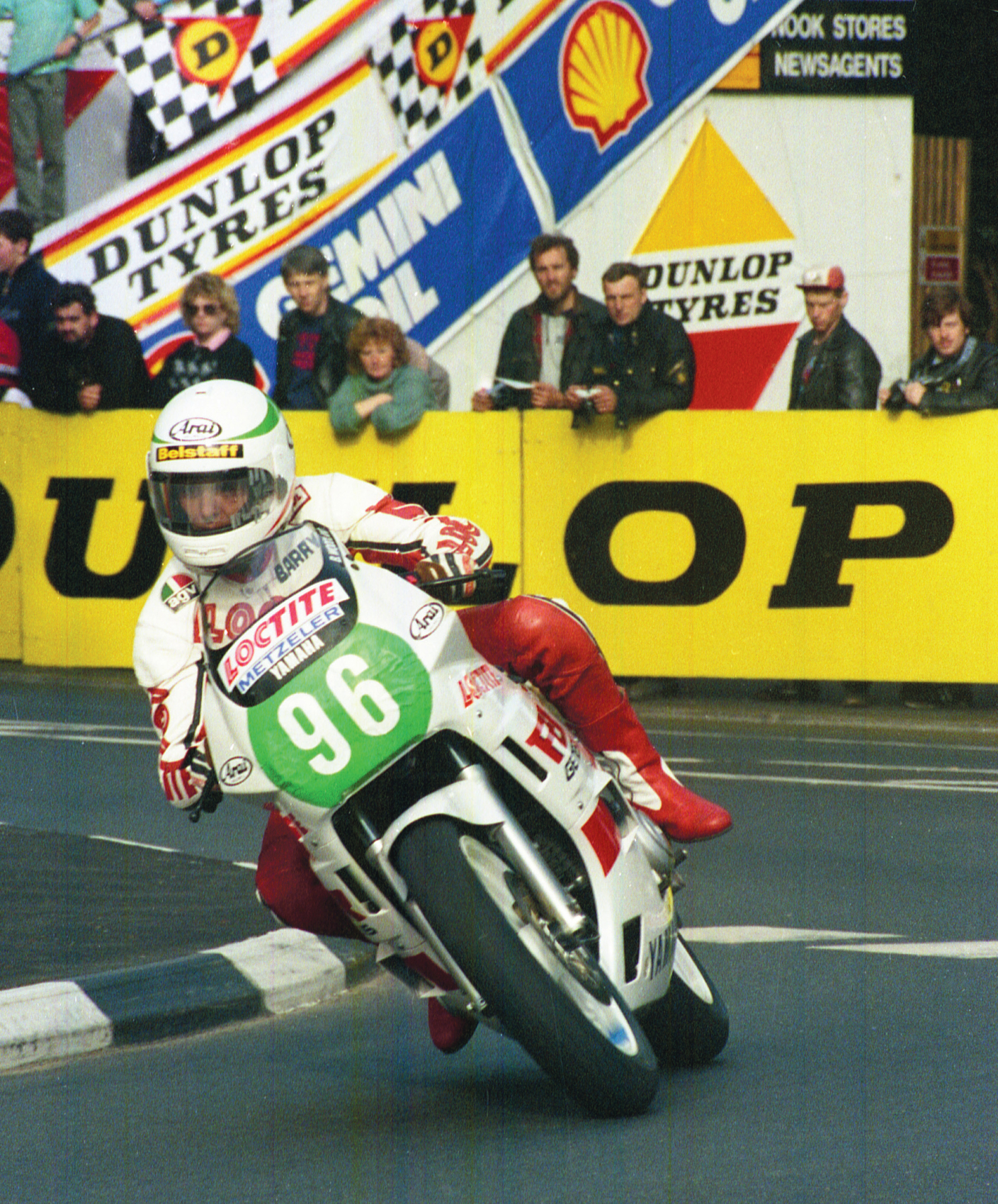
Barry Woodland rounds Quarter Bridge on his 400cc Yamaha on his way to victory in 1988 Production Race D.

DAVID WRIGHT

THE CROWOOD PRESS
First published in 2017 by
The Crowood Press Ltd
Ramsbury, Marlborough
Wiltshire SN8 2HR
www.crowood.com
This e-book first published in 2017
David Wright 2017
All rights reserved. No part of this publication may be reproduced or transmitted in any form or by any means, electronic or mechanical, including photocopy, recording, or any information storage and retrieval system, without permission in writing from the publishers.
British Library Cataloguing-in-Publication Data
A catalogue record for this book is available from the British Library.
ISBN 978 1 78500 299 1
CONTENTS
INTRODUCTION AND ACKNOWLEDGEMENTS
Every year in late May and early June, tens of thousands of people journey to the Isle of Man to be present at an event known the world over simply as The TT. For two weeks, the roads that make up the 37 miles of the famed Isle of Man Mountain Course are given over to top motorcycle racers, to ride the fastest bikes of the day in pursuit of one of the most highly coveted prizes in motorcycle racing: a Tourist Trophy.
This is the way it has been for 110 years, during which time the annual event has evolved from a single race into a festival of motorcycling. But however varied the interests on show, the main reason for the high-octane atmosphere that envelops the Island during those two weeks is the unfettered spectacle of raw speed generated by racing over the public roads of the TT Mountain Course.
It was the opportunity to break free from the shackles of mainland Britains then 20mph speed limit and to ride faster than the next man that brought the first motorcycle TT to the Isle of Man in 1907. Recognized from the outset as being one of motorcyclings greatest challenges, for over a century the island has attracted the very best road racers, while successive generations of followers have crowded the roadside banks and marvelled at the way in which riders have gone ever faster at this unique event.
In the following pages you can read about the attraction of speed to competitors and spectators, and how faster motorcycles have caused the time required to lap the Mountain Course to shrink from 45 minutes to under 17 minutes. Also considered are how changes to the roads and the rules of racing have affected race speeds, plus the many factors in the development of racing motorcycles that have contributed to lap speeds growing from an average of just over 40mph to well in excess of 130mph. All this is interwoven with the history of the event and will leave you in no doubt that it is speed that has shaped most aspects of the now legendary TT races.
ACKNOWLEDGEMENTS
A book like this cannot be written without assistance across many areas and I am grateful for the support provided by Stan Basnett, David and Joan Crawford, Ralph Crellin, Tony East, Geoff Judges, Paul Wright, Manx National Heritage and the VMCC Library. The database on www.iomtt.com was consulted on several occasions and found to be very useful.
Photographs to illustrate the theme of Speed have been supplied by Stan Basnett, Ron Clark, David and Joan Crawford, Juan Cregeen, John Dalton, Paul Ingham, Alan and Mike Kelly of Mannin Collections, Ray Knight Archives, Brian Maddrell, Doug Peel, Geoff Preece, Richard Radcliffe, Elwyn Roberts, Rob Temple, Paul Wright, Bill Snelling of FoTTofinders and Mortons Media.
The author has made every effort to locate and credit the source of the hundreds of photographs used in the book. If any have not been properly acknowledged, please accept my apologies.
Special thanks go to Vic Bates for providing considerable input to this project, drawing maps of the several TT courses, taking photographs to illustrate riders at particular locations on the course and making his photo archive available for use.
CHAPTER ONE
GATHERING MOMENTUM
Followers of the Isle of Man Tourist Trophy races are interested in many aspects of the annual event, but the dominant attraction to most of them has always been the spectacle of raw and unbridled speed on offer over the roads of the famed and feared Mountain Course. Through successive generations of TT racing, spectators have marvelled as riders have exhibited their skills and courage over those public roads, while extracting maximum performance from their machines. Each will have given their all, but history confirms that it has always been the fastest riders who commanded the most attention, received the greatest publicity and entered the record books.
Much has been written to explain mans wish to travel ever faster, but just one week after the first TT race in 1907, when the event faced criticism from some quarters, The Motor Cycle magazine neatly summarized the situation with the words: It is useless to say that fast speeds are not to be encouraged, human nature being what it is.
Top motorcycle racers have always demanded the very best motorcycles to ride and over a century of effort has now been committed to developing more powerful racing engines, together with improved transmissions, suspension, brakes, tyres, electrics and the like, all with the aim of putting better machines into the hands of riders, to travel ever faster around the 37-mile lap of the TT Mountain Course. Has all that effort been successful? Well, in the first running of the race for the Tourist Trophy over the Mountain Course in 1911, winner Oliver Godfrey thrilled spectators with speeds they had never before experienced, as he rode his c10bhp Indian to first place at a race average speed of 47.63mph, reaching perhaps 65mph in the process. In 2016 Michael Dunlop did exactly the same with his 220-plus bhp BMW as he rode to victory at a race average speed of 130.68mph, while hitting close to 200mph. That simple comparison reflects over 100 years growth in power and speed, substantial technical progress and an awful lot of excitement.
EARLY TT RACES
The first Tourist Trophy race for motorcycles was run in 1907, over ten laps of a 15-mile circuit in the west of the island called the St Johns Course.
It presented a challenge for motorcycles of the era, for they were still in an early stage of development. Though billed as a race, out and out speed was not the main target of the first event: in words of the day, the Tourist Trophy race was created for the development of the ideal touring motorcycle. To help achieve that ideal, machines were equipped with silencers, had to carry a specified minimum weight of tools, be fitted with a proper saddle and use touring-type mudguards. The regulation that had most influence on speeds, however, was the one that specified fixed allocations of fuel for the race. This was limited to 1 gallon for every 90 miles of race distance for single-cylinder machines and 1 gallon per 75 miles for those with more than one cylinder. For many competitors the effect of that regulation was to govern the speed at which they could race, because trying to run at maximum throttle would see them use up their fuel before completion of the 158-mile total distance.

